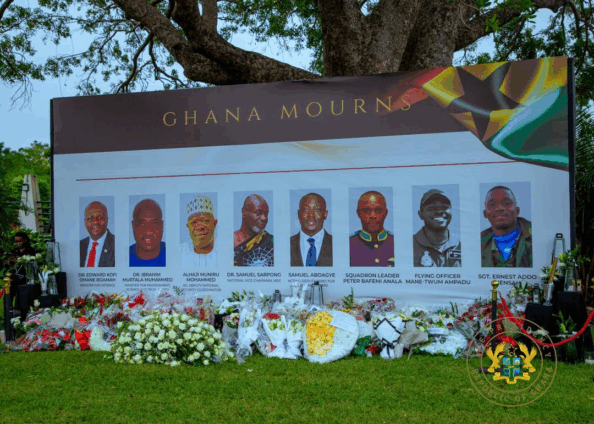The Ghana Armed Forces (GAF) has come under intense public scrutiny following the tragic helicopter crash in Obuasi on August 6, 2025, after videos and images circulated showing victims initially placed in cocoa sacks instead of conventional body bags. The Chief of Defence Staff (CDS), Lt. Gen. William Agyapong, has now provided an explanation for the decision, citing the extreme conditions at the crash site.
Lt. Gen. Agyapong clarified that while body bags were available at the scene, the remains of the victims were extremely hot, making it unsafe and impractical to place them directly into the plastic containers. The GAF team on site faced a difficult choice in the dense forested area, where nightfall was approaching rapidly. Leaving the bodies unattended until the next day could have led to additional risks, he explained.
“In that environment, we had to make an immediate decision with the materials at hand,” the CDS said, adding that cocoa sacks provided a temporary and practical solution to begin the descent from the crash site. The swift action, he emphasized, was intended to preserve the dignity of the fallen and to allow for proper handling once safer conditions were reached.
Once the victims were transported down the hill, the remains were carefully placed into official body bags. Some of these had been sent from AngloGold Ashanti, while others were brought by the military medical team, ensuring that all eight victims were eventually secured appropriately for transport and burial preparations.
The Chief of Defence Staff’s statement comes in the wake of public concern and questions about the apparent improvised handling of the deceased at the crash site. He stressed that the measures taken were dictated by environmental realities and urgency, and not by a lack of resources or planning.
Lt. Gen. Agyapong urged the public to consider the extreme conditions faced by the rescue and recovery teams and highlighted the professionalism of all personnel involved in the operation. His remarks aim to clarify misconceptions and provide context to the controversial images that have circulated since the incident.
The tragic crash, which claimed the lives of eight military personnel and government officials, has continued to draw national attention, prompting calls for improved safety protocols and emergency preparedness for aviation and military operations in challenging terrains.



